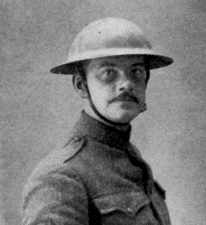
Joyce Kilmer Memorial Forest-Slickrock Wilderness
- Distance: 2 miles.
- Difficulty: easy.
Home to giant old-growth trees
Joyce Kilmer Memorial Forest is an impressive Eastern example of old-growth forest. Some of its trees are a hundred feet tall, twenty feet in circumference and four hundred years old. You may need binoculars to be certain of the species. The 3800-acre tract (small by Forest Service standards but nineteen times larger than the BJU campus) was named a memorial to the American poet Joyce Kilmer (1886-1918), killed in action during World War I and best known for his poem “Trees.” (Kilmer wrote the poem while looking out his window in Mahwah, New Jersey, so he was certainly not thinking of these forest giants.)
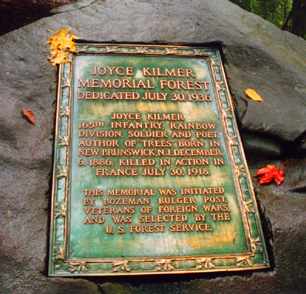
Chestnut blight in the virgin forest
A decline in lumber prices at the beginning of the Great Depression helped save what was virgin woodland, and the tract contains huge examples of oak, yellow-poplar, and basswood, among others. Missing is the chestnut, once the dominant tree of the forest, a victim of the chestnut blight accidentally introduced during the early twentieth century. Although the last of the Kilmer chestnuts were probably dead by the late 1930s, their wood is so rot-resistant that remnants of massive stumps and logs are still discernible on the ground. So, ironically, although Joyce Kilmer is a magnificent uncut forest, it is not one that would be recognized by either aboriginal tribes or European pioneers. The area was spared the saw because of a decline in lumber prices at the beginning of the Great Depression and because a logging railway had to be removed before the lower section of its roadbed was flooded behind Calderwood Dam.
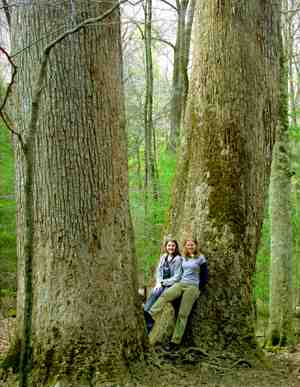
Exploded hemlocks
Another major and more recent loss is the death of almost all the hemlocks due to an infestation of an exotic insect, the hemlock woolly adelgid. The Forest Service tried treating the hemlocks, but almost all died anyway. Concerned that a falling limb or tree might crush a visitor, Forest Service managers then decided bring down dead trees near the trail in a way they believed would mimic the effect of storms. In November 2010, they blew up the trees with explosives. Not surprisingly, the landscape of the lower loop of the trail has been completely altered. Besides being much lighter and drier, the lower trail also resembles a battlefield–an ironic result in a memorial dedicated to a war casualty. Fortunately the tulip poplars were completely unaffected by the woolly adelgid, and there are big trees and comparatively unaltered forest to enjoy in the upper loop trail.
Leisurely walk, likely wet
Take U.S. 129 north to NC
1127 and park at the Joyce Kilmer Picnic Area, about ten miles from the Cottage. An easy two-mile, figure-eight trail leads to some of the largest of the trees. The Smokies get a lot of rain—an average of eighty inches a year—and the Memorial Forest lies in the watershed of Little Santeetlah Creek, so wear shoes and pants that might get a bit muddy along the way.
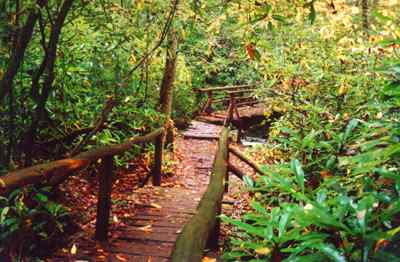
Part of the underappreciated Joyce Kilmer-Slickrock Wilderness Area
Joyce Kilmer is part of the larger (17,000 acre) Joyce Kilmer-Slickrock Wilderness area designated by Congress in 1975. It is one of the most underused wilderness areas in the East. (When visitors come to the Smokies from afar, they tend to ignore natural areas outside the boundaries of Smoky Mountain National Park.) Slickrock Wilderness includes more than sixty miles of trails, including some fine ones accessible from a trailhead opposite Cheoah Dam, about nine miles north of the Cottage on U.S. 129. (Click here for more information.)
Nearby Maple Springs Observation Point
Next to the entrance of Joyce Kilmer Memorial Forest is the road to Maple Springs Observation Point, from which you can view Santeetlah Lake and the Smoky Mountains at an elevation of 3500 feet.
Other trails in the area
Nearby Slickrock trail offers a longer hike along two streams.
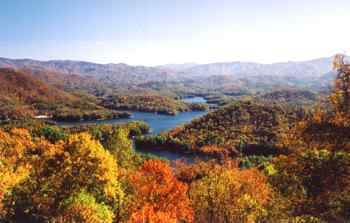
“Trees”
Joyce KilmerI think that I shall never see
A poem as lovely as a tree.A tree whose hungry mouth is prest
Against the earth’s sweet flowing breast;A tree that looks at God all day,
And lifts her leafy arms to pray;A tree that may in Summer wear
A nest of robins in her hair;Upon whose bosom snow has lain;
Who intimately lives with rain.Poems are made by fools like me,
But only God can make a tree.